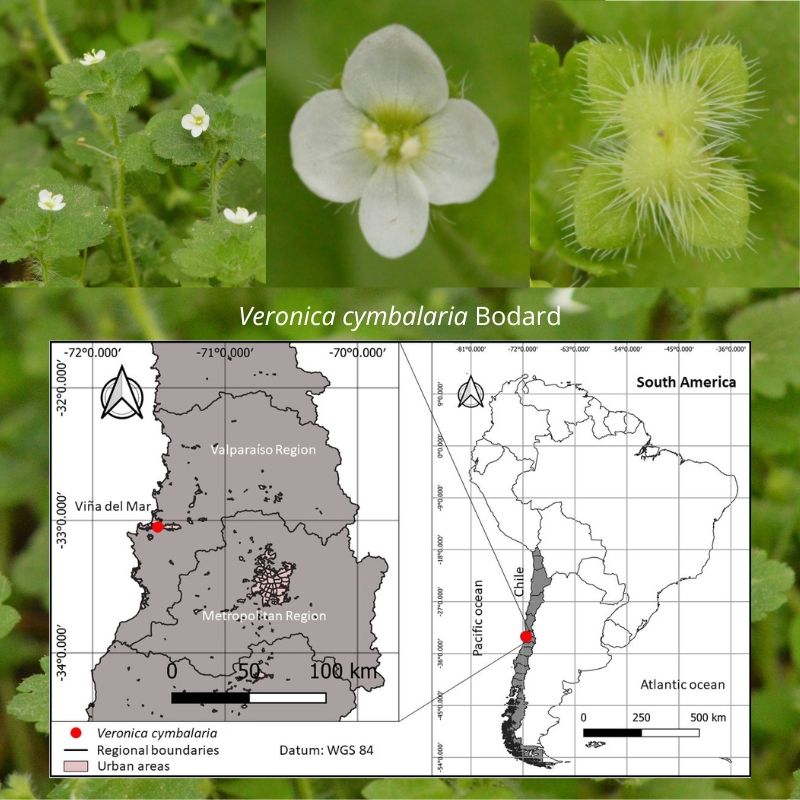Veronica cymbalaria (Plantaginaceae): A new species for the exotic flora of Chile.
DOI:
https://doi.org/10.31055/1851.2372.v58.n2.37621Palavras-chave:
Alien plant, central Chile, flora of Chile, taxonomy, Valparaíso Region, weedsResumo
Background and aims: Botanic gardens play a fundamental role in conservation due to the maintenance of seed and live plant collections. However, the exchange of ornamental plant seeds between botanic gardens can facilitate the entry of seeds of alien species with invasive potential. In 2018, during a visit to the collections of the National Botanical Garden (Chile), we discovered populations of an herb of the genus Veronica (Plantaginaceae). The aim of this paper is to report for the first time the presence of Veronica cymbalaria as a new exotic feral species for the flora of Chile.
M&M: Live material was studied and compared with the original description of the species. The collected material was deposited in the herbarium of the National Botanical Garden (JBN).
Results: Veronica cymbalaria, which grows abundantly in and around the biological collections of the National Botanical Garden, is described. Images of the species, a map of the site of occurrence and a key to distinguish Veronica species growing in Chile are included.
Conclusions: Veronica cymbalaria is reported for the first time for the flora of Chile. The distribution range of this alien species is extended to southern America. The genus Veronica is represented by ten allochthonous species in Chile.
Downloads
Referências
ALBACH, D. C. 2007. Amplified fragment length polymorphisms and sequence data in the phylogenetic analysis of polyploids: multiple origins of Veronica cymbalaria (Plantaginaceae). New Phytologist. 176: 481-498. https://doi.org/10.1111/j.1469-8137.2007.02172.x DOI: https://doi.org/10.1111/j.1469-8137.2007.02172.x
ALBACH, D. C. & H. M. MEUDT. 2010. Phylogeny of Veronica in the Southern and Northern Hemispheres based on plastid, nuclear ribosomal and nuclear low-copy DNA. Mol. Phylogenet. Evol. 54: 457-471. https://doi.org/10.1016/j.ympev.2009.09.030 DOI: https://doi.org/10.1016/j.ympev.2009.09.030
BORISSOVA, A. G. 1955. Veronica L. In: Shishkin, B. K. & E. G. Bobrov. (eds.), Flora of the U.S.S.R., vol. 22, pp. 372-745. Akademii Nauk SSSR, Moscow-Leningrad.
DOGRA, K. S., S. K. SOOD, P. K. DOBHAL & S. SHARMA. 2010. Alien plant invasion and their impact on indigenous species diversity at global scale: A review. J. Ecol. Nat. Environ. 2: 175-186. https://doi.org/10.5897/JENE.9000012
FUENTES, N., P. SÁNCHEZ, A. PAUCHARD, J. URRUTIA, L. CAVIERES & A. MARTICORENA. 2014. Plantas Invasoras del Centro-Sur de Chile: Una Guía de Campo. Laboratorio de Invasiones biológicas (LIB), Concepción.
GBIF. 2021. Veronica cymbalaria Bodard. GBIF Backbone Taxonomy. Checklist dataset https://www.gbif.org/species/3172068 via GBIF.org [Accessed: 22 July 2021].
HULME, P. 2015. Resolving whether botanic gardens are on the road to conservation or a pathway for plant invasions. Biol. Conserv. 29: 816-824. https://doi.org/10.1111/cobi.12426 DOI: https://doi.org/10.1111/cobi.12426
JUAN, R., I. FERNÁNDEZ & J. E. PASTOR. 1995. Ecología de la germinación en especies del género Veronica (Scrophulariaceae) del SO de España. Acta Bot. Malac. 20: 43-50. DOI: https://doi.org/10.24310/abm.v20i.8824
MARTÍNEZ-ORTEGA, M. M., & E. RICO. 2000. Algunas tipificaciones y combinaciones nuevas en las Veronica L. (Scrophulariaceae) perennes. Anales Jard. Bot. Madrid 57: 477-479.
MATTHEI, O. 1995. Manual de las malezas que crecen en Chile. Alfabeta Impresores, Santiago.
MAUNDER, M., S. HIGGENS & A. CULHAM. 2001. The effectiveness of botanic garden collections in supporting plant conservation: a European case study. Biodivers. Conserv. 10: 383-401. https://doi.org/10.1023/A:1016666526878 DOI: https://doi.org/10.1023/A:1016666526878
MITO, T. & T. UESUGI. 2004. Invasive alien species in Japan: the status quo and the new regulation for prevention of their adverse effects. Glob. Environ. Res. 8: 171-193.
POLECHOŃSKA, L., M. GLEŃSK, A. KLINK, M. DAMBIEC & Z. DAJDOK. 2020. Allelopathic potential of invasive wetland plant Veronica peregrina. Plant Biosyst. 154: 481-487. https://doi.org/10.1080/11263504.2019.1635225 DOI: https://doi.org/10.1080/11263504.2019.1635225
REICHARD, S. H. & WHITE, P. 2001. Horticulture as a pathway of invasive plant introductions in the United States: most invasive plants have been introduced for horticultural use by nurseries, botanical gardens, and individuals. BioScience 51: 103-113. https://doi.org/10.1641/0006-3568(2001)051[0103:HAAPOI]2.0.CO;2 DOI: https://doi.org/10.1641/0006-3568(2001)051[0103:HAAPOI]2.0.CO;2
RODRÍGUEZ, R., C. MARTICORENA, D. ALARCÓN, C. BAEZA, L. CAVIERES, … & A. MARTICORENA. 2018. Catálogo de las plantas vasculares de Chile. Gayana Bot. 75: 1-430. http://dx.doi.org/10.4067/S0717-66432018000100001 DOI: https://doi.org/10.4067/S0717-66432018000100001
ROJAS-ANDRÉS, B. & M. MARTÍNEZ-ORTEGA. 2016. Taxonomic revision of Veronica subsection Pentasepalae (Veronica, Plataginaceae sense APG III). Phytotaxa 285: 1-100. https://doi.org/10.11646/phytotaxa.285.1.1 DOI: https://doi.org/10.11646/phytotaxa.285.1.1
ROMERO, M. & H. KLEMPAU. 1981. El género Veronica L. (Scrophulariaceae) en Chile. Anales Mus. Hist. Nat. Valparaiso 14: 85-98.
TAKAKURA, K. 2013. Two-Way but asymmetrical reproductive interference between and invasive Veronica species and a native congener. Am. J. Plant Sci. 4: 535-542.
https://doi.org/10.4236/ajps.2013.43069 DOI: https://doi.org/10.4236/ajps.2013.43069
VALDÉS, B., C. SANTA-BÁRBARA, C. VICENT & A. MUÑOZ. 2008. Catálogo florístico del Andévalo y Sierra de Huelva (plantas vasculares). Lagascalia 28: 117-409.
WU, H., S. QIANG & G. PENG. 2010. Genetic diversity in Veronica hederifolia (Plantaginaceae), an invasive weed in China, assessed using AFLP markers. Ann. Bot. Fenn. 47:190-198. https://doi.org/10.5735/085.047.0303 DOI: https://doi.org/10.5735/085.047.0303
ZULOAGA, F., O. MORRONE, M. BELGRANO (eds.). 2018. Catálogo de las plantas vasculares del cono sur (Argentina, Sur de Brasil, Chile, Paraguay y Uruguay). http://www2.darwin.edu.ar/Proyectos/FloraArgentina/fa.htm [Accessed: 10 May 2022]. DOI: https://doi.org/10.14522/darwiniana.2019.72.861

Downloads
Publicado
Como Citar
Edição
Seção
Licença
Copyright (c) 2023 Mauricio Cisternas, Arón Cádiz-Véliz, Patricio Novoa, Jorge Macaya-Berti

Este trabalho está licenciado sob uma licença Creative Commons Attribution-NonCommercial-NoDerivatives 4.0 International License.
Proporciona ACESSO ABERTO imediato e livre ao seu conteúdo sob o princípio de tornar a pesquisa livremente disponível ao público, o que promove uma maior troca de conhecimento global, permitindo que os autores mantenham seus direitos autorais sem restrições. 
Material publicado em Bol. Soc. Argent. Bot. é distribuído sob uma licença Creative Commons Attribution-NonCommercial-ShareAlike 4.0 International License. 








